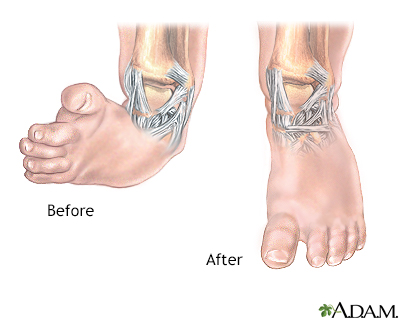Clubfoot
Talipes equinovarus; Talipes
Clubfoot is a condition that involves both the foot and lower leg in which the foot turns inward and downward. It is a congenital condition, which means it is present at birth.
Images

Presentation

Causes
Clubfoot is the most common congenital disorder of the legs. It can range from mild and flexible to severe and rigid.
The cause is not known. Most often, it occurs by itself. But the condition may be passed down through families in some cases. Risk factors include a family history of the disorder and being male. Clubfoot can also occur as part of an underlying genetic syndrome, such as trisomy 18.
A related problem, called positional clubfoot, is not true clubfoot. It results from a normal foot positioned abnormally while the baby is in the womb. This problem is easily corrected after birth.
Symptoms
The physical appearance of the foot may vary. One or both feet may be affected.
The foot turns inward and downward at birth and is difficult to place in the correct position. The calf muscle and foot may be slightly smaller than normal.
Exams and Tests
The disorder is identified during a physical examination.
A foot x-ray may be done. Ultrasound during the first 6 months of pregnancy can also help to identify the disorder.
Treatment
Treatment may involve moving the foot into the correct position and using a cast to keep it there. This is often done by an orthopedic specialist. Treatment should be started as early as possible, ideally, shortly after birth, when it is easiest to reshape the foot.
Gentle stretching and recasting will be done every week to improve the position of the foot. Generally, 5 to 10 casts are needed. The final cast will stay in place for 3 weeks. After the foot is in the correct position, the child will wear a special brace nearly full time for 3 months. Then, the child will wear the brace at night for 3 to 5 years.
Often, the problem is a tightened Achilles tendon, and a simple procedure is needed to release it.
Some severe cases of clubfoot will need surgery if other treatments do not work, or if the problem returns. The child should be monitored by your health care provider until the foot is fully grown.
Outlook (Prognosis)
The outcome is usually good with treatment.
Possible Complications
Some defects may not be completely fixed. However, treatment can improve the appearance and function of the foot. Treatment may be less successful if the clubfoot is linked to other birth disorders.
When to Contact a Medical Professional
If your child is being treated for clubfoot, contact your provider if:
- The toes swell, bleed, or change color under the cast
- The cast appears to be causing significant pain
- The toes disappear into the cast
- The cast slides off
- The foot begins to turn in again after treatment
References
Martin S. Clubfoot (talipes equinovarus). In: Copel JA, D'Alton ME, Feltovich H, et al. Obstetric Imaging: Fetal Diagnosis and Care. 2nd ed. Philadelphia, PA: Elsevier; 2018:chap 64.
Warner WC, Beaty JH. Paralytic disorders. In: Azar FM, Beaty JH, eds. Campbell's Operative Orthopaedics. 14th ed. Philadelphia, PA: Elsevier; 2021:chap 34.
Winell JJ, Davidson RS. The foot and toes. In: Kliegman RM, St. Geme JW, Blum NJ, Shah SS, Tasker RC, Wilson KM, eds. Nelson Textbook of Pediatrics. 21st ed. Philadelphia, PA: Elsevier; 2020:chap 694.
BACK TO TOPReview Date: 11/6/2023
Reviewed By: Neil K. Kaneshiro, MD, MHA, Clinical Professor of Pediatrics, University of Washington School of Medicine, Seattle, WA. Also reviewed by David C. Dugdale, MD, Medical Director, Brenda Conaway, Editorial Director, and the A.D.A.M. Editorial team.

Health Content Provider
06/01/2025
|
A.D.A.M., Inc. is accredited by URAC, for Health Content Provider (www.urac.org). URAC's accreditation program is an independent audit to verify that A.D.A.M. follows rigorous standards of quality and accountability. A.D.A.M. is among the first to achieve this important distinction for online health information and services. Learn more about A.D.A.M.'s editorial policy, editorial process and privacy policy. A.D.A.M. is also a founding member of Hi-Ethics. This site complied with the HONcode standard for trustworthy health information from 1995 to 2022, after which HON (Health On the Net, a not-for-profit organization that promoted transparent and reliable health information online) was discontinued. |
The information provided herein should not be used during any medical emergency or for the diagnosis or treatment of any medical condition. A licensed medical professional should be consulted for diagnosis and treatment of any and all medical conditions. Links to other sites are provided for information only -- they do not constitute endorsements of those other sites. © 1997- 2025 A.D.A.M., a business unit of Ebix, Inc. Any duplication or distribution of the information contained herein is strictly prohibited.
